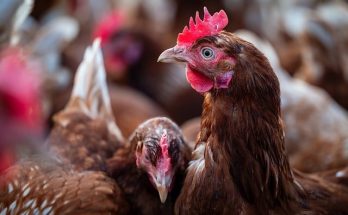Ignorance or none application of appropriate toxin binder prophylactics strategically, in health management system for breeder and commercial stock production may continue to account for more vertically and horizontally transmitted Aflatoxin compromised DOC in the region.
The health status of a chick or a flock is a function of many factors such as the gene quality, climatic elements (temperature, relative humidity, rainfall etc), the environment (particularly the housing parameters), diet and management. These altogether can influence the performance of birds as they grow to become valuable producers of egg and meat. Farmers in Nigeria are recording persistent vaccination failures to Newcastle Diseases (ND), Infectious Bursa Diseases (IBD) and Marek’s Diseases (MD) even when breeder and hatchery operators had recognized and implemented IBD and Mareks vaccination in their operations. Resistances and vaccination failures in poultry can be linked to the role of underlining mycotoxins as a major hazardous factor interfering with immune response synergy to the effectiveness of chemotherapy and vaccinations in breeder and commercial operations.

Mycotoxin effect on breeders can permeate through the hatchery to manifest on the health and performance status of the emerging offspring even when they are adequately vaccinated at the hatchery or subsequently at the commercial farm level. Mycotoxins contamination and influence on immunopathology of breeders and commercial DOC affects capacity to produce adequate maternal and active immunity, and this constitute a major etiology and potentiating factors for various post hatchery vaccination failures and resistances development observed in the Nigeria poultry sector of the region. Mycotoxin negative impacts on efficient chemotherapy and on immune response integrity for upstream and downstream poultry segment may negate the CCDP and AU NEPAD target achievement of a 6% agricultural growth for a region.
West Africa poultry must focus on improved health status and sustainability to achieve the anticipated growth for the region. Growth must be reflected in all sectors of the industry moving vertically from the upstream sector of breeders’ production through the hatchery operative system to the downstream commercial sector of the industry. Private initiative advocacy and contributions from observations derivable from field studies analysis will contribute in reductions of sanitary risks and diseases transmission in the region in other to boost food security for over 240 million consumers of the region that needed safe poultry and hygienic value added products.
With Nigeria contribution of 50% of the human population and about 50% table eggs and broiler meat output in the region, the role of mycotoxin in numerous vaccination failures and bacteria resistances to available antibiotics will pose serious threat to production of viable DOC with immunological integrity for the region. Ignorance or none application of appropriate toxin binder prophylactics strategically, in health management system for breeder and commercial stock production may continue to account for more vertically and horizontally transmitted Aflatoxin compromised DOC in the region.
It is therefore mandatory from this study to conclude that strategic and prophylactic application of broad spectrum toxin binders and especially the new generations of Nanotoxin binders should be approved as zoo phytosanitary requirement mandatory for the movement of DOC across the boarders in the region in other to achieve the anticipated growth for the region and provide safe poultry and poultry food products for the region.
To learn more, read and download this publication, visit LIFA’s Resource Page or Engormix Article Page as this paper traces a vertical relationship of mycotoxins transfer and its immuno-pathological implications on the health status of the upstream (Breeders) and the down stream (DOC) segment of the Industry by providing comprehensive case studies from poultry health management operations in Nigeria.





The menace of Toxins in the poultry industry is very glaring. Quality control on available Binders to ensure effectiveness may be lacking. Wholesome Toxin binders is the immediate solution, since feed raw materials are not specifically produced for poultry industry.
I have noticed the dangers being caused by Live Fungi especially Aspergillus in growing chickens. Apart from preventive measures, direct therapeutic medicament is not common in drug stores in Nigeria.
Thank you Dr Anyanwu for your useful contribution and your appreciation of the huge risk mycotoxins and fungi infections pose to animal food security in the humid tropical climate especially in the South Sahara Africa,(SSA)
I agree with your suggestion that a dual approach strategy to mitigate systemic fungi infections and toxin will best serve as an holistic approach to the management of fungi and their complimentary metabolites called mycotoxins
Available antifungal like neo station, Acraflavin ,were sometimes available in the market to manage aspergillosis we had found copper sulphate also useful but at very low dosage to avoid copper sulphate poison
However,of recent a new probiotic product called Nutrox now marketed in Nigeria will serve the fungicidal purpose
I raised up the issue of the management of systemic mycotoxins in the last meeting of the technical committee of PAN Africa Committee on Aflatoxin Mitigation(PACA) last December 2017 in Abuja as a member representing an NGO on livestock ,where I raised opposition on the n
on inclusion of CVN unlike NAIS that was conspicuously budgeted as organ responsible for Aflatoxin Mitigation in feed
I do not oppose this idea,but tried to impress it of the committee that Aflatoxin may escape feed mitigation level into the animal system as well as been systemically produced in the system by aspergillus hyphae
Who will prevent the passage of toxaemia and aspergillus infected meat to humans?
Of course it is the veterinarians who are fully registered and regulated by the Council ,which unfortunately was not given this mandate in PACA
Vet Council should wake up to her responsibility and take up her role in the management of safe animal food to the teaming population of this country